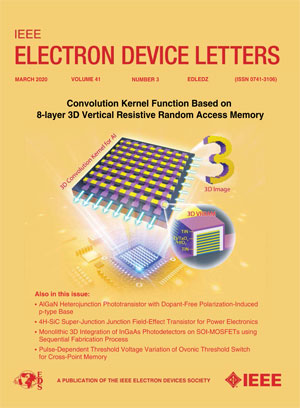Enhanced Cooling of Multifinger GaN HEMTs via Topside Diamond Integration
IF 4.5
2区 工程技术
Q2 ENGINEERING, ELECTRICAL & ELECTRONIC
引用次数: 0
Abstract
Gallium nitride high electron mobility transistors (HEMTs) are key components for today’s 5G power amplifiers. However, device overheating requires commercial devices to operate under derated power levels. This work reports the cooling effectiveness of a top-side diamond heat spreader for a 16-finger GaN/SiC HEMT using gate resistance thermometry. A通过顶部钻石集成增强多指GaN hemt的冷却
氮化镓高电子迁移率晶体管(hemt)是当今5G功率放大器的关键组件。然而,设备过热要求商用设备在降额功率水平下运行。本研究报告了采用栅极电阻测温技术的16指GaN/SiC HEMT的顶部金刚石散热片的冷却效果。在12w /mm时,厚度为2~\mu $ m的金刚石散热片可使栅温升高降低~20%。仿真结果表明,要实现器件热阻(${\ mathm {R}}_{{\text {Th}}}$)降低10%,需要金刚石厚度大于$1.5~\mu $ m。为了使${\math {R}}_{{\text {Th}}}$降低10%,$2~\mu $ m厚的金刚石层的导热系数需要大于450 W/m $\cdot $ K,并且SiN保护层应薄于75 nm。在模拟中,与标准GaN/SiC HEMT相比,加入上部金刚石并用金刚石取代SiC衬底可使${\ mathm {R}}_{{\text {Th}}}$降低42.2%。
本文章由计算机程序翻译,如有差异,请以英文原文为准。
求助全文
约1分钟内获得全文
求助全文
来源期刊

IEEE Electron Device Letters
工程技术-工程:电子与电气
CiteScore
8.20
自引率
10.20%
发文量
551
审稿时长
1.4 months
期刊介绍:
IEEE Electron Device Letters publishes original and significant contributions relating to the theory, modeling, design, performance and reliability of electron and ion integrated circuit devices and interconnects, involving insulators, metals, organic materials, micro-plasmas, semiconductors, quantum-effect structures, vacuum devices, and emerging materials with applications in bioelectronics, biomedical electronics, computation, communications, displays, microelectromechanics, imaging, micro-actuators, nanoelectronics, optoelectronics, photovoltaics, power ICs and micro-sensors.
 求助内容:
求助内容: 应助结果提醒方式:
应助结果提醒方式:


